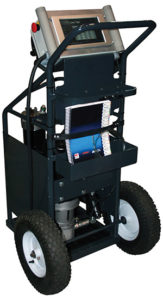What causes contamination?
Particulate contaminants circulating in fluid power systems cause surface degradation through general mechanical wear (abrasion, erosion, and surface fatigue). Dan Zoller, Group Product Manager Filter Systems, Schroeder Industries, explained that this wear causes increasing numbers of particles to be formed, the result being that wear increases if the “chain reaction of wear” is not properly contained (by reducing contamination).
“Gaps grow larger, leakage oil flows increase in size and operating efficiency (e.g. of pumps, cylinders) decreases. To avoid this, the objective is always to remove particulate contamination in new systems, before start-up, and later when the system is in use,” he said.
New hydraulic systems
“The overall contamination level of a hydraulic system being built in an assembly plant is generally high,” Zoller said. “The total contamination (particulates) consists of contamination that already exists in the new fluid, contamination that is already on/in supplied components and contamination introduced during the build process from the surroundings. The sum of all the contamination can be considered the Initial Contamination Level.”
“Therefore, the objective is to reduce this Initial Contamination Level. The investment in time and equipment to reduce the Initial Contamination Level is worthwhile because of a reduction of costly warranty claims and for quality control and tracing purposes of products,” he said, adding that incoming warranty claims can be investigated and might be connected to maintenance activities at the customer location.
“For example, if the fluid was not maintained to recommended cleanliness standards during use, e.g. what was achieved when the equipment left manufacturing, a warranty claim could be rejected. Overall, manufacturers have found that clean hydraulic systems will reduce the occurrence of failure during the warranty period,” he said.

Rebuilt hydraulic systems
Zoller said that every system that was running for a while eventually needs maintenance, repairs or rebuilt work. “Therefore, it simply makes good practice that after the work has concluded and before full system start, flushing of the hydraulic fluid is recommended to remove the particulates that have been added due to parts exchanges, being open to the dirty environment and due to the work performed (e.g. metal on metal contact creates particulates that end up in the hydraulic system).”
The flushing process
There are systems available to handle this flushing task, both using in system or off-line filter systems. “The fluid in the reservoir should be flushed with a filter cart or a kidney lop system,” Zoller said. “It is recommended to flush the system and all the sub-functions by activating them to allow fluid to circulate and to flush particulates back in to the tank where they can be captured, either by the system filters (e.g. return filters) or by external, off-line filter systems (filter carts, kidney loop systems).
Zoller concluded that a general rule is to achieve a cleanliness level of the hydraulic fluid in the reservoir that is 1 to 2 ISO Codes below the recommended Target Fluid Cleanliness level for the system.
By Joice Laird


Leave a Reply